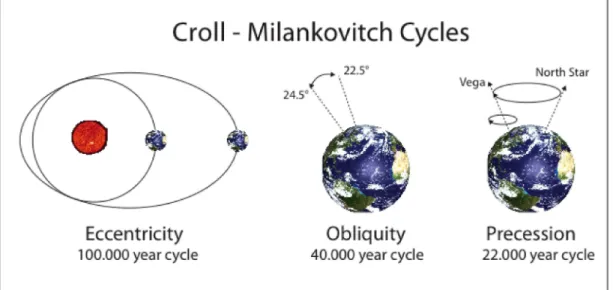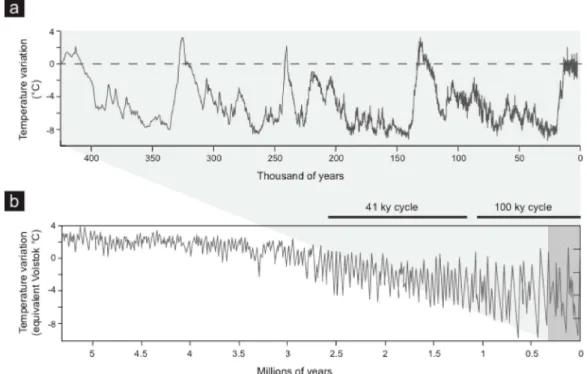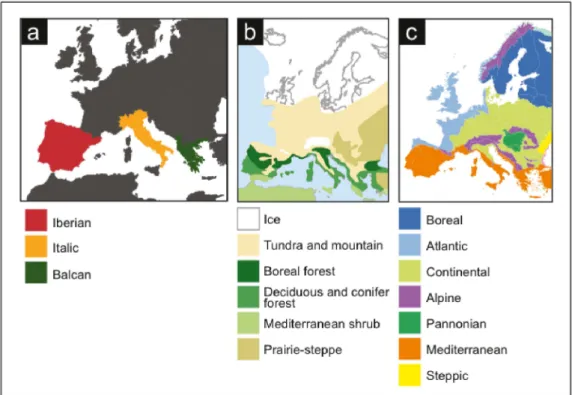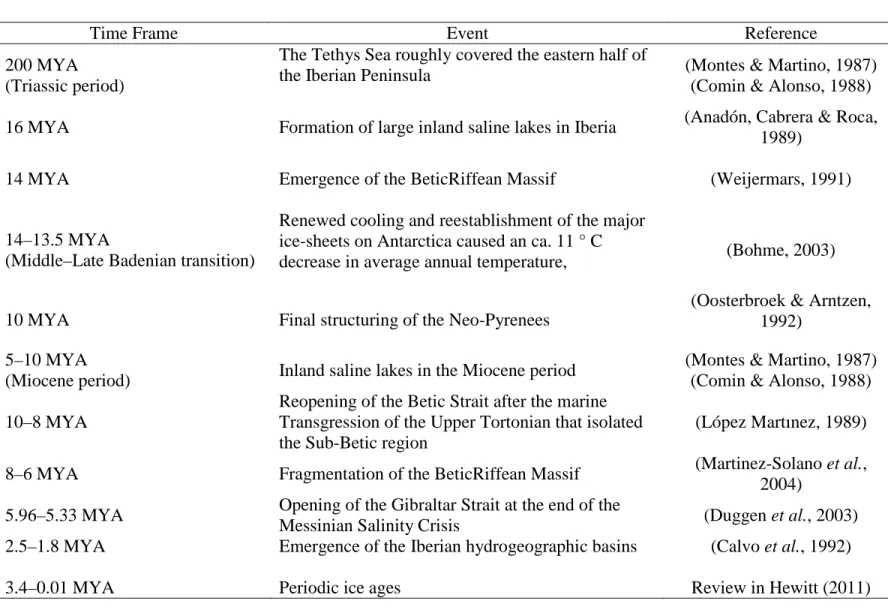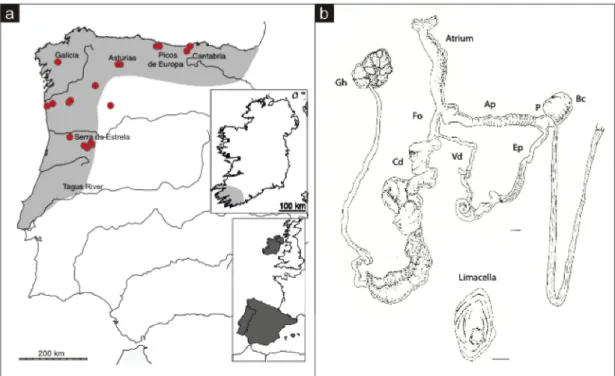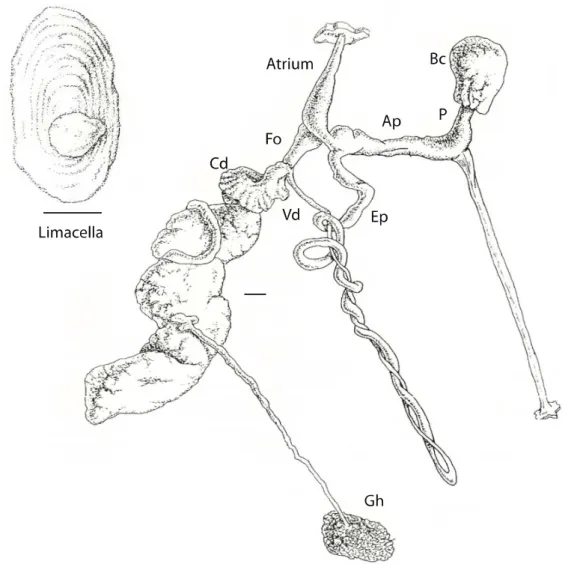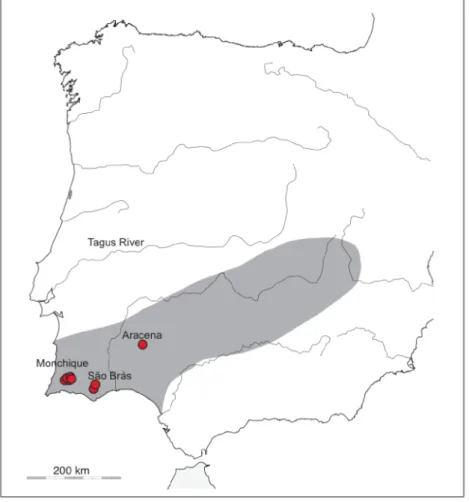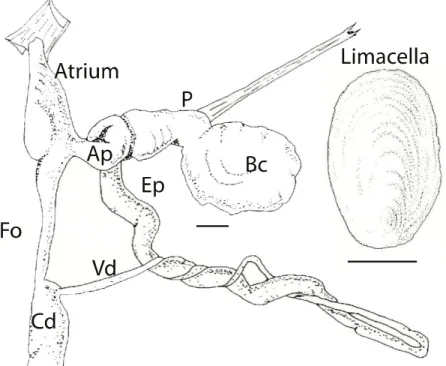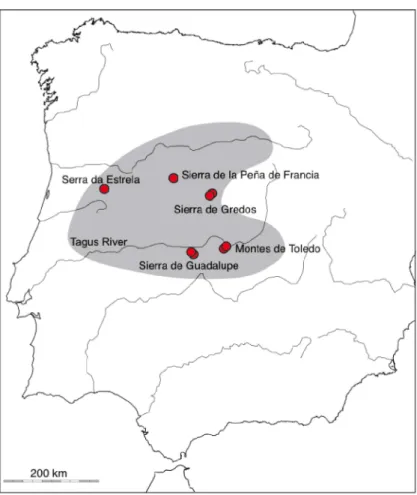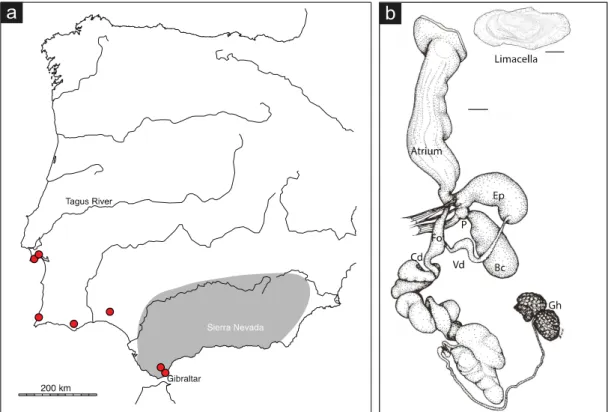UNIVERSIDADE DO ALGARVE
Faculdade de Ciências e Tecnologia
Ecological niche modeling, cytogenetics and
phylogeography of the genera Geomalacus
and Letourneuxia (Gastropoda, Pulmonata)
from the Iberian-Moroccan region
Cláudia Sofia Patrão Beliz Rosa e Silva
Doutoramento em Ciências Biológicas
Especialidade em Biologia Evolutiva
Trabalho realizado sob a orientação de:
Professora Doutora Rita Castilho
Doctor Thierry Backeljau
UNIVERSIDADE DO ALGARVE
Faculdade de Ciências e Tecnologia
Ecological niche modeling, cytogenetics and
phylogeography of the genera Geomalacus
and Letourneuxia (Gastropoda, Pulmonata)
from the Iberian-Moroccan region
Cláudia Sofia Patrão Beliz Rosa e Silva
Doutoramento em Ciências Biológicas
Especialidade em Biologia Evolutiva
Trabalho realizado sob a orientação de:
Professora Doutora Rita Castilho
Doctor Thierry Backeljau
A realização desta tese foi possível graças ao financiamento da
Fundação para a Ciência e Tecnologia, com co-financiamento do
Fundo Social Europeu, através da bolsa de doutoramento
Declaração de autoria de trabalho:
Declaro ser a autora deste trabalho, que é original e inédito. Autores e trabalhos consultados estão devidamente citados no texto e constam da listagem de referências incluída.
Copyright Cláudia Sofia Patrão Beliz Rosa e Silva. A Universidade do Algarve tem o direito, perpétuo e sem limites geográficos, de arquivar e publicitar este trabalho através de exemplares impressos reproduzidos em papel ou de forma digital, ou por qualquer outro meio conhecido ou que venha a ser inventado, de o divulgar através de repositórios científicos e de admitir a sua cópia e distribuição com objetivos educacionais ou de investigação, não comerciais, desde que seja dado crédito ao autor e editor.”
Agradecimentos / Acknowledgments
Em primeiro lugar quero agradecer à Professora Rita Castilho ter aceite orientar o presente trabalho e por tudo o que me ensinou sobre o mundo da filogenia e filogeografia. Obrigada pelas suas sugestões que permitiram melhorar os manuscritos, por passar-me o gosto pela bioinformática e partilhar comigo, de forma generosa, o seu talento nato para a parte gráfica.
To Thierry, thank you for being so kind with your knowledge, sharing the love you have for science in general and slugs in particular, opening my eyes to a new world – malacology. Your humor, your endless lists of PDF’s, even really obscure scientific publications - you are truly the PDF God! I will forever remember all those late night really interesting science discussions in Antwerp/Brussels/Thailand/Azores…
Obrigada Alexandra por me teres mostrado o mundo dos cromossomas, descobri uma nova paixão na ciência, numa área que nunca pensei estudar. Obrigada pela tua (enorme) paciência e por me teres apresentado formas novas de olhar para o mundo científico. És uma inspiração pelo modo como consegues balançar todas as valências da tua vida. Obrigada também a todas as pessoas da estação de moluscicultura do IPMA de Tavira: à Joana que me ajudou de forma tão generosa no trabalho de laboratório, à Tila, Sandra e Margarete que tornaram os meus dias na estação tão divertidos.
Thank you Kurt, you were the one that taught me all about “slug hunting” and allozymes. I really enjoyed the time I spent in Universiteit Antwerpen. And, of course, Natalie, that so patiently taught me all about the secrets of the lab!
Um grande bico para Tere, que me ensinaste tudo o que sabias sobre o mundo misterioso dos Geomalacus em Portugal, que compreendes o meu entusiasmo sobre este assunto e que tão fundamental foste na identificação morfológica dos especimens que recolhi.
To the members of the Jury for taking time from their busy schedules for reading my thesis and to participate in the defense.
A todas as pessoas que entraram neste jogo da caça à lesma, me enviaram amostras, me telefonaram e mandaram fotos de tudo o que rastejava: a minha tia Ana, Professor Karim (e aos jardineiros incansáveis, o meu shukran bezzef), Neiva, Gonçalo, Davide, Nelson, Licínia, Esti, Mirijam, Paula Cesário, Verónica Mascarenhas e Mª Clotilde Ribeiro o meu MUITO OBRIGADA!
A todos vocês do grupo BEE do CCMAR que me aturaram, ajudaram e inspiraram, fazendo com que estes anos no laboratório fossem do melhor que há! Pati, Davide (vais ser o melhor médico de sempre!), Mirjiam, Onno, Buga, Rita, Catarina, Pablo, Cristina (leia-se Quitina), Tânia Pereira, Sónia Massa, Maria João, Regina (a tua assertividade é uma inspiração), Xana que é uma força da natureza, com um poder de multitasking e organização sem par; Nelson, és o “mai” lindo do lab e, já sabes, o mais arrumadinho, you are the king of the lab; à Licínia (a tua coragem e boa disposição são a tua marca); ao Neiva, o mais despassarado, o protótipo do cientista que nem sabe onde tem as pipetas nem a chave de casa; à Joaninha voa-voa, que
voaste para o outro lado do mundo, mas vais estar sempre no meu coração, à Aires, que estás sempre tão perto de mim, mesmo tão longe, tenho saudades tuas, ao GANG da marmita, estivemos na moda, ainda antes do tempo e ao Gonçalo um obrigada muito especial, ao longo destes anos todos foste o “outro”, estiveste comigo no laboratório e no campo, transformando as saídas de amostragem em aventuras para contar aos bisnetos, aturaste de tudo, o mau humor noturno, o sono, a fome, as birras, os momentos de desespero, TUDO. És um “must” OBRIGADA!
À Vanya, que estás sempre lá quando é preciso, que conduzes kms na neve para me apoiares, a minha cicerone na Bélgica! Para sempre tens lugar de destaque no meu coração, uma amiga que vai ficar para toda a vida.
A todos os meus amigos espalhados pelo mundo inteiro, que me apoiaram, que acreditaram (mesmo quando eu já não acreditei) e me incentivaram a não desistir, me ajudaram a seguir em frente, OBRIGADA.
À minha família, que me ajudou ao longo destes anos, que acredita em mim. Ao meu Pai, Avó, Tias e Primas! À minha Mãe que é a melhor do mundo, incansável, sempre pronta a ajudar. Ao Alexandre, que é o meu pilar, é o capitão do barco sempre que eu não estou presente (e nestes últimos anos eu sei que isso acontece muito mais vezes do que seria desejável...), obrigada pelo teu apoio incondicional durante estes últimos meses de escrita ta tese. E aos meus filhos, que são o Sol e a Lua dos meus dias!
“(…) I look at the term species, as one arbitrarily given for the sake of convenience to a set of individuals closely resembling each other, and that it does not essentially differ from the term variety, which is given to less distinct and more fluctuating forms. The term variety, again, in comparison with mere individual differences, is also applied arbitrarily, and for mere convenience sake.”
Abstract
First described more that 150 years ago, the systematics of the genera Geomalacus and Letourneuxia (Arionidae, Gastropoda, Pulmonata) is still challenging. The taxonomic classification of arionid species is based on extremely labile characters such as body size or color that depends both on diet and environment, as well as age. Moreover, there is little information on the genetic diversity and population structure of the Iberian slugs that could provide extra clues to disentangle their problematic classification.
The present work uses different analytical tools such as habitat suitability (Ecological Niche Modeling - ENM), cytogenetic analysis and phylogeography to establish the geographical distribution and evolutionary history of these pulmonate slugs.
The potential distribution of the four Geomalacus species was modeled using ENM, which allowed the identification of new locations for G. malagensis, including a first report in Portugal. Also, it was predicted a much wider distribution for G. malagensis and G. oliveirae than previously known. Classical cytogenetic analyses were assayed with reproductive and a novel use of somatic tissues (mouth and tentacles) returning the number of chromosomes for the four Geomalacus species and L. numidica (n = 31, 2n = 62) and the respective karyotypes. G. malagensis and L. numidica present similar chromosome morphologies and karyotypic formulae, being more similar to each other than the Geomalacus among themselves.
We further reconstructed the phylogeny of the genera Geomalacus and Letourneuxia using partial sequences of the mitochondrial cytochrome oxidase subunit I (COI) and the nuclear ribosomal small subunit (18S rRNA), and applied an independent evolutionary rate method, the indicator vectors correlation, to evaluate the existence of cryptic diversity within species. The five nominal species of Geomalacus and Letourneuxia comprise 14 well-supported cryptic lineages. Letourneuxia numidica was retrieved
as a sister group
of G. malagensis. G. oliveirae is paraphyletic with respect to G. anguiformis. According to our dating estimates, the most recent common ancestor of Geomalacus dates back to the Middle Miocene (end of the Serravallian stage). The major lineage splitting events within Geomalacus occurred during the dry periods of the Zanclean stage (5.3-3.6 million years) andsome lineages were confined to more humid mountain areas of the Iberian Peninsula, which lead to a highly geographically structured mitochondrial genetic diversity.
The major findings of this are the following: (1) provides updated species distribution maps for the Iberian Geomalacus expanding the known geographic distribution of the concerned species, (2) unravels the cryptic diversity within the genera Geomalacus and Letourneuxia, (3) Geomalacus oliveirae is paraphyletic with G. anguiformis and (4) Letourneuxia numidica is sister group of G. malagensis.
Keywords: Gastropoda, Geomalacus, Letourneuxia, Iberian Peninsula, habitat
suitability, karyotype, phylogeography, biogeography.Resumo
Apesar de inicialmente descritos há mais de 150 anos, a sistemática dos géneros de lesmas terrestres Ibero-Marroquinas Geomalacus e Letourneuxia (Arionidae, Gastropoda, Pulmonata), continua a não ser consensual. A classificação taxonómica das espécies da família Arionidae é baseada em caracteres plásticos, tais como o tamanho do corpo e a coloração do tegumento, que dependem não só da dieta e do ambiente mas também da idade dos indivíduos. Para além disso, informação que poderia auxiliar na problemática da classificação destes organismos, como a diversidade genética e estrutura populacional, é bastante escassa. No presente trabalho foram utilizadas diferentes ferramentas de análise tais como modelação de nicho ecológico (ENM), análises de citogenética e filogeografia, para actualizar a distribuição geográfica conhecida e desvendar a história evolutiva destas lesmas terrestres.
A distribuição potencial das quatro espécies de Geomalacus (G. maculosus, G. oliveirae, G. anguiformis e G. malagensis) foi modelada usando ENM. Os resultados permitiram identificar novas localizações para G. malagensis, entre elas o primeiro registo da espécie em Portugal e adicionalmente foi prevista uma distribuição mais alargada para G. malagensis e G. oliveirae do que a previamente descrita na bibliografia.
Análises de citogenética clássica foram realizadas em tecidos reprodutivos e, inovadoramente, em tecidos somáticos (boca e tentáculos). As quatro espécies de Geomalacus e L. numidica apresentaram n = 31, 2n = 62 cromossomas tendo sido obtidos os respectivos cariótipos. As espécies G. malagensis e L. numidica apresentaram fórmulas cariotípicas e morfologias cromossómicas semelhantes, sendo mais próximas entre si do que G. malagensis e as restantes espécies do género.
A reconstrução filogenética dos géneros Geomalacus e Letourneuxia, com sequências parciais da subunidade I do gene mitocondrial citocromo c oxidase e da subunidade ribossomal nuclear 18S. As cinco espécies de Geomalacus e Letourneuxia apresentaram 14 linhagens crípticas suportadas pelos elevados valores de ‘bootstrap’. Letourneuxia numidica apareceu como ‘grupo-irmão’ da espécie G. malagensis e G. oliveirae revelou-se parafilético em relação a G. anguiformis. De acordo com as estimativas, o ancestral comum mais recente de Geomalacus remonta ao Mioceno Médio, final do período Serravaliano. Dentro do género Geomalacus, a principal
divisão de linhagens ocorreu durante as secas do período Zancleano (5.3-3.6 milhões de anos), ficando algumas linhagens restritas a áreas montanhosas mais húmidas da Península Ibérica, o que provocou uma elevada diversidade genética mitocondrial bem estruturada geograficamente.
As principais contribuições deste trabalho são: (1) a actualização dos mapas de distribuição geográfica para as espécies Ibéricas do género Geomalacus, (2) a revelação de diversidade críptica dentro dos géneros Geomalacus e Letourneuxia, (3) a existência de parafilia entre Geomalacus oliveirae e G. anguiformis e (4) o posicionamento de Letourneuxia numidica como ‘grupo-irmão’ de G. malagensis.
Palavras-chave:
Gastropoda, Geomalacus, Letourneuxia, Peninsula Ibérica, ENM, cariótipo, filogeografia, biogeografia.Table of Contents
AIMS AND CHAPTERS ... 1
CHAPTER I. GENERAL INTRODUCTION ... 4
1. Study area: The Iberian Peninsula – endemisms and glacial refugia ... 5
2. The species concept problem, taxonomy and evolutionary significant units ... 9
3. The terrestrial Arionids of the Iberian Peninsula ... 12
4. The genera Geomalacus and Letourneuxia: current taxonomy, distribution and ecology. ... 15
4.1 The genus Geomalacus ... 15
4.2 The genus Letourneuxia ... 26
CHAPTER II ... 29
HABITAT SUITABILITY MODELLING OF FOUR TERRESTRIAL SLUG SPECIES IN THE IBERIAN PENINSULA (GASTROPODA, PULMONATA: GEOMALACUS SP.) ... 29
Abstract ... 31
Introduction ... 32
Material and methods ... 34
Results ... 38
Discussion ... 42
Acknowledgments ... 45
CHAPTER III ... 59
GEOMALACUS AND LETOURNEUXIA (MOLLUSCA, PULMONATA): A CYTOGENETIC ASSESSMENT ... 59
Introduction ... 61
Materials and methods ... 63
Results ... 65
Discussion ... 66
Acknowledgements ... 69
CHAPTER IV ... 71
CRYPTIC DIVERSITY OF GEOMALACUS AND LETOURNEUXIA IN THE IBERIAN-MOROCCAN REGION ... 71
Introduction ... 73
Material and Methods ... 76
Results ... 79 Discussion ... 84 Concluding remarks ... 87 CHAPTER V ... 109 GENERAL CONCLUSIONS ... 109 Distribution of Geomalacus spp. ... 110
Novel use of somatic tissue in cytogenetic studies of land slugs ... 110
Phylogenetic assessment and taxonomic implications ... 111
Conservation implications ... 112
GENERAL REFERENCES ... 114
Aims and Chapters
The present work aims at understanding the taxonomy and biogeography of the genera Geomalacus and Letourneuxia (Gastropoda, Pulmonata), with different analytical tools: habitat suitability or ecological niche modeling (ENM), cytogenetic analysis, phylogeography and species delimitation methods, with the purpose of clarifying the taxonomy, geographical distribuition and genetic diversity of this complex and poorly studied genera of the subfamily Arioninae. With this purpose five chapters were developed.Chapter I provides a general introduction to phylogeography and terrestrial malacofauna of the Iberian Peninsula and explores species concepts and merits of integrative taxonomy. Finally, the current knowledge on the taxonomy, ecology and biology of the species investigated in this study is presented.
In Chapter II the potential distribution of the four Geomalacus species was modeled using Ecological Niche Modeling. New populations of G. malagensis were uncovered and, for the first time, the presence of this species in Portugal is reported. New potential areas of distribution are presented.
Chapter III deals with chromosome counts and karyotypes of the four Geomalacus species and Letourneuxia numidica, assessing to which extent cytogenetic data distinguishes the two genera and their subgenera. Different somatic tissues (mouth and both optical and sensory tentacles) were tested to evaluate their suitability for karyological studies. Results show that the different somatic tissues are suitable for cytogenetic studies and that the haploid chromosome number of the genera Geomalacus and Letourneuxia is n = 31. Also, the karyotypes of G. malagensis and L. numidica present similar chromosome morphologies and karyotypic formulae.
In Chapter IV, the phylogeny of Geomalacus and Letourneuxia across their Iberian-Moroccan distribution was inferred using sequence fragments of the mitochondrial cytochrome c oxidase subunit I (COI) and the nuclear ribosomal small subunit (18S rRNA) genes. Evolutionary significant units, i.e., unique reciprocally monophyletic genetic lineages were identified. Geomalacus oliveirae returned as a paraphyletic taxon comprising G. anguiformis, and five cryptic lineages. The main clades were dated and a biogeographical scenario is offered to explain the genetic structure of Geomalacus/Letourneuxia.
Finally, CHAPTER V provides a synthesis of the results of the preceding chapters and highlights the main contributions of this work.
Chapter I
General Introduction
Chapter I. General Introduction
Biogeography, a centenary discipline founded by Alfred Russel Wallace, is the study of the distribution of species and ecosystems through space and time, an essential discipline to understand not only the where and when, but also the “how come” (Lomolino et al., 2010). How come are species distributed across a certain range and were they always there? How come are there shifts in the occupancy of landscape throughout time? How come certain species are absent from some locations, if apparently the optimal biotic conditions are met? When the spatial distribution of genetic variability was added to the geographical distribution of organisms ‘phylogeography’1 (Avise et al., 1987) was born, opening new possibilities to unravel the natural history of species. Since then three main advents have influenced phylogeography: the use of new molecular marker classes, such as microsatellites and Single Nucleotide Polymorphisms (SNPs), the development of analytical tools and habitat suitability modeling. New analytical tools have been developed to address specific matters, such as historical demography, calibration built-in phylogenies and landscape genetics. New algorithms that integrate the known geographical distribution of species with arrays of environmental variables of that distribution (Franklin, 2010; Guisan & Thuiller, 2005) allow the prediction of easy to interpret past and present geographic distribution maps.
1
Biogeography was defined by Avise (1998) as “The field of study concerned with the principles and processes governing the geographical distributions of genealogical lineages, especially those at the intraspecifc level”.
1.
Study area: The Iberian Peninsula – endemisms and glacial
refugia
Invertebrates show a wide variety of life histories and a tolerance for different temperatures and humidity; therefore studying the genetic variation of invertebrates on a range-wide scale may clarify the recent history of postglacial expansion and the location of refugia (Hewitt, 2001). The way invertebrates react to glacial and interglacial periods received less attention than the vertebrates and the existing studies only cover limited geographical areas referring mostly to insects (Gómez & Lunt, 2007). However, the large majority of phylogeographical studies has been focused on vertebrates, in particular mammals (Taberlet & Bouvet, 1994; Santucci, Emerson & Hewitt, 1998; Igea et al., 2013), birds (Griswold & Baker, 2002; Hampe et al., 2003; Neto et al., 2012), fishes (Weiss et al., 2000; Machordom & Doadrio, 2001; Mesquita et al., 2007; Faria, Weiss & Alexandrino, 2012), reptilians (Fritz et al., 2006; Joger et al., 2007; Velo-Antón, García-París & Cordero Rivera, 2008; Kornilios et al., 2010), amphibians (Martinez-Solano et al., 2006; Reis et al., 2011; Valbuena-Ureña, Amat & Carranza, 2013) and some insects (Cooper & Hewitt, 1993; Lunt, Ibrahim & Hewitt, 1998; Gomez-Zurita, Petitpierre & Juan, 2000; Miraldo et al., 2011).
Figure 1.1. Cyclic variation in the orbit of Planet Earth (Croll - Milankovitch cycles) With the beginning of the Tertiary period (~65.5 Million years ago – MYA), temperatures have changed dramatically, and the most recent global climate event, the last ice age, marked the beginning of the Pleistocene period (2.5 MYA - 10 thousand
years ago). The quaternary glaciations had major influence shaping the spatial species/population structure: the cyclic variation in the orbit of Planet Earth (Croll-Milankovitch cycles, Figure 1.1) lasts around 100 thousand years (Muller & MacDonald, 1997) and is responsible for dramatic climate changes – glaciations – producing shifts in population ranges: during ice ages, species distribution becomes reduced and fragmented, and organisms tend to migrate south due to the expansion of ice sheets from the pole covering most of the northern hemisphere (Hewitt, 1996; Thompson & Russell, 2005) (Figure 1.2). During glacial periods, some geographic areas became ‘refugia’ for different species of fauna and flora. These long cold periods were interrupted by short, warm interglacial periods, lasting around 10 KY each. During these interglacial periods, populations on the edge of the ice sheets tended to migrate North rapidly (some species are known to have migrated between hundreds of meters and 1 km per year, e.g. (Hewitt, 2001), accompanying the rise in global temperatures (Hewitt, 2000; Thompson & Russell, 2005), colonizing the available ice-free land. These successive shifts between glacials and interglacial periods are responsible for a variety of phylogenic patterns in species (Hewitt, 2000). Table 1.1 includes a list of dated paleogeographic and climatic events that preceded the last ice age, in the Iberian Peninsula.
Figure 1.2. Temperature change. a) Reconstructed temperature from the Vostok ice core for the past 420.000 years (Petit et al., 1999) and b) reconstructed temperature by combining measurements from 57 globally distributed deep-sea sediment cores for the past 5 MY (Lisiecki & Raymo, 2005).
The Iberian Peninsula, along with the Italian and Balkan Peninsulas are considered important refugia during glacial periods where species survived during temperature oscillations (Hewitt, 1999)(Figure 1.3). Iberia has a particular geological history that allows the existence of several microhabitats. The physiographic complexity, with several large mountain ranges, that display an east-west orientation (Gómez & Lunt, 2007), is responsible for a multitude of microclimates and habitats, across different altitude ranges, allowing species to occupy different niches, at different altitudes, as climate conditions changes (Hewitt, 1996). Also, due to the unique geographic location, the Iberian Peninsula is under the influence of the North Atlantic Ocean and Mediterranean Sea, inducing diverse climate conditions: from desert to Alpine, Mediterranean to Atlantic. Therefore it is expected that this variety of microclimates is responsible for more than one single refugia in the entire Peninsula (Gómez & Lunt, 2007). In fact, García-Barros (2002) identified 36 areas of high endemism in Iberia and concluded that these were mostly concordant with mountain ranges.
Figure 1.3. Europe and a) The three European Peninsulas; b) Vegetation cover during the Last Glacial Maximum; c) Map of the biogeographic regions of Europe (source: European Environmental Agency).
Table 1.1 - Paleogeographic, hydrographic and climatic events in the Iberian Peninsula; time frame in million years ago (MYA).
Time Frame Event Reference
200 MYA (Triassic period)
The Tethys Sea roughly covered the eastern half of
the Iberian Peninsula (Montes & Martino, 1987)
(Comin & Alonso, 1988)
16 MYA Formation of large inland saline lakes in Iberia (Anadón, Cabrera & Roca,
1989)
14 MYA Emergence of the BeticRiffean Massif (Weijermars, 1991)
14–13.5 MYA
(Middle–Late Badenian transition)
Renewed cooling and reestablishment of the major ice-sheets on Antarctica caused an ca. 11 ° C
decrease in average annual temperature, (Bohme, 2003)
10 MYA Final structuring of the Neo-Pyrenees
(Oosterbroek & Arntzen, 1992)
5–10 MYA
(Miocene period) Inland saline lakes in the Miocene period
(Montes & Martino, 1987) (Comin & Alonso, 1988) 10–8 MYA
Reopening of the Betic Strait after the marine Transgression of the Upper Tortonian that isolated the Sub-Betic region
(López Martınez, 1989)
8–6 MYA Fragmentation of the BeticRiffean Massif (Martinez-Solano et al.,
2004)
5.96–5.33 MYA Opening of the Gibraltar Strait at the end of the
Messinian Salinity Crisis (Duggen et al., 2003)
2.5–1.8 MYA Emergence of the Iberian hydrogeographic basins (Calvo et al., 1992)
2.
The species concept problem, taxonomy and evolutionary
significant units
Taxonomy, the science that describes and classifies species is the cornerstone of biology. Without a clear classification of the organisms, the work of conservationists becomes impaired, hindering management and conservation policies regarding selection of conservation areas and formulation of biodiversity plans (Agapow et al., 2004). It is crucial to establish taxonomic units that can be managed and handled not only by biologists but also by decision makers (Dayrat, 2005). However, what is actually a species has been debated for centuries. The task of describing and classifying species can become overwhelming, since the definition of species is, in itself, debatable and highly dependent on which species concept is being used. At the present, biologists use more than 25 species concepts, for compilation see Wilkins (2011), and the large majority of studies do not clearly state under what kind of species concept they are considering (Bininda-Emonds, 2011). Since Mayr (1942), authors have addressed this problem, and discussed the implications of using different concepts in different studies (see Wilkins (2003) for a philosophical review) and how this differences can have an impact on results (Agapow et al., 2004).
The taxonomy of many land slugs remains equivocal because it is based almost exclusively on morphological characters. Therefore their traditional classification is based on one of the following species concept: Morphospecies Concept, Phenetic Species Concept or the classical Biological Species Concept. Morphospecies concept is probably one of the oldest, with its origin in Aristotle and Linnaeus. More recently, (Cronquist, 1978) defined the concept as the smallest groups that are consistently and persistently distinct, and distinguishable by ordinary means. The Phenetic Species Concept (PSC) describes species as a set of organisms that look similar to each other and distinct from other sets (Monaghan et al., 2009; Ridley, 1993) and the Biological Species Concept (BSC), made popular by Mayr (1942), consists in interbreeding natural population isolated from other such groups dependent upon endogenous reproductive isolating mechanisms (Mayr, 1970; Mayr & Ashlock, 1991).
Differentiating land slug species based on the internal and external morphology can be challenging since they often lack reliable diagnostic morphological traits. Their body size and color exhibit extreme variability (Backeljau & De Bruyn, 1990) and it is well known that the color of slugs is dependent on several factors, such as available food source, age and environment (Jordaens et al., 2001). Aso, the morphology of their variable reproductive apparatus, which varies according to developmental stage and sexual maturation, often prevents the correct identification of juveniles at the species level (Backeljau & De Bruyn, 1990 and references therein; Backeljau et al., 1996). These challenges compromise the use of the morphospecies and the PSC when describing new species. Also, the BSC, the one most biologist still prefer, present a major problem: it is either impossible, extremely time consuming or just too expensive to test if individuals are actually reproductive isolated (Agapow et al., 2004). Moreover, usually species are identified on a subjective assessment of phenotypic distinctness (Sokal & Crovello, 1970). In organisms where facultative self-fertilization is common, defining species is extremely challenging, since these taxa may produce phenotypically divergent strains due to fixation and linkage disequilibria of alternative alleles in different multilocus genotypes (e.g. (Backeljau et al., 1996; Geenen, Jordaens & Backeljau, 2006; Jordaens et al., 2000). This would result in morphospecies, but not in real different biological species.
A different approach could be the use of the Phylogenetic Species Concept (PSC) that defines species, as a diagnosable cluster of individual organisms within which there is a parental pattern of ancestry and descent (Cracraft, 1983; Cracraft, 1989) or monophyly (de Queiroz & Donoghue, 1988; de Queiroz & Donoghue, 1990; Donoghue, 1985), in short, a lineage. This concept is easier to apply than the non-phylogenetic species concepts in general, since it can be applied to asexual organisms and allopatric populations (Agapow et al., 2004). Also, by not relying on morphological characters, morphological indistinct species may be found and because it incorporates both the history and phylogeny it is more useful for the classification and preservation of biodiversity (Hibbett & Donoghue, 1996). Obviously this approach also has its shortcomings; there is no clear definition about the amount of variation needed to define a species and this amount of variation is likely to vary among different taxa – which could prompt subspecies or even individual organisms
to be classified as species, for instances in cases of uniparental systems where gene flow is restricted e.g. (Amadon & Short, 1992; Coyne & Orr, 2004; Isaac & Purvis, 2004). Obviously the opposite is also possible by overemphasizing potential gene flow between populations, and therefore aggregating different species together (Agapow et al., 2004). Also, since phylogenies are not seldomly based on single genes, the result is actually a phylogeny of a gene, which may not be concordant with the phylogeny of the species due to events like incomplete lineage sorting, gene duplication (or loss) and horizontal gene transfer (Mindell & Meyer, 2001; Slowinski & Page, 1999). This may result in a higher number of species, with more restricted geographic ranges and decreased abundance (Agapow et al., 2004). Therefore, it is better to rely on multiple (e.g. molecular, cytogenetic, ecological, behavioral) data to clarify taxonomic problems, i.e. in the present case that of the genera Geomalacus and Letourneuxia.
Recently the idea of integrative taxonomy has been proposed as a holistic tool that relies on a multitude of independent data (i.e. morphological, molecular, ecological, behavioral) allowing more accurate classifications (Dayrat, 2005; Yeates et al., 2011). This approach has been used in terrestrial molluscs, where independent data sources were used to identify cryptic species (Jordaens et al., 2010; Pinceel et al., 2004) and to explore the species level status of land snails (Prévot et al., 2013). Still, a question remains, is species level enough to represent lineage variation? The concept of ESU - evolutionary significant unit, was first catapulted into the lexicon of ecologist and evolutionary biologists by Ryder(1986) and was, at the time, used mainly for purposes of conservation, since species level fell shy of representing all genetic diversity that should be under conservation effort (Avise, 1989). As Moritz (1994) stated, "the recognition of ESUs is primarily relevant to long-term management issues, that is, defining conservation priorities and setting strategy”. This concept should not clash, but instead, complement the traditional “species” definition, since, in some species concepts, ESU and “species” are actually the same thing. Blaxter (2004) proposes the terminology MOTU (molecular operational taxonomic units), that falls within the phylogenetic (or lineage) species concept, to identify clades of organisms that can be perceived as “species”. To conclude, it is at least as important to describe and name species, and the relationship between them, as it is to understand how many “units” or “lineages” those species represent.
3.
The terrestrial Arionids of the Iberian Peninsula
The nineteenth century was prolific in scientific work on terrestrial slugs in Portugal and Spain (Mabille, 1867; Morelet, 1845; Morelet, 1877; Pollonera, 1890b; Pollonera, 1890a; da Silva e Castro, 1873; da Silva e Castro, 1887; Simroth, 1888; Simroth, 1891; Simroth, 1893; Nobre, 1889), but very few authors (Haas, 1929; Nobre, 1930; Nobre, 1941) revisited this subject during the twentieth century, though in Spain it suffered less hiatus than in Portugal. It was only in the final of the 1970’s that several studies advanced on the taxonomy and distribution of terrestrial slugs in Portugal (Castillejo, 1981; Castillejo, Rodríguez & Outeiro, 1987; Castillejo, Rodríguez & Outeiro, 1989; Seixas, 1976; 1977; 1978). An exhaustive listing of slug species present in Portugal and a classification based on internal morphology (reproductive organs and ligula) was produced in 1989 by Rodriguez. In the last decade of the past century, three books with all the species of slugs present in the Iberian Peninsula with available distribution maps were published (Castillejo & Rodriguez, 1991; Castillejo, 1997; Castillejo, 1998), as well as several morphology studies on arionids (e.g. Castillejo, 1992; Castillejo, 1993; Castillejo, Garrido & Iglesias, 1994; Garrido, Castillejo & Iglesias, 1994; Garrido, Castillejo & Iglesias, 1995).
Though the taxonomy of terrestrial slugs is well documented (but not resolved), there is only paper dealing with the phylogeny and phylogeography of Iberian Arion sp. (Quinteiro et al., 2005). In contrast, there is a myriad of publications attempting biogeographic scenarios of Iberian amphibians e.g. (Alexandrino et al., 2000; Alexandrino et al., 2007; Altaba, 1997; Solano et al., 2004; Martinez-Solano et al., 2006; Teixeira, Ferrand & Arntzen, 2001). While biologically completely different from terrestrial gastropods, amphibians have also low dispersal abilities (Staub, Brown & Wake, 1995) and are highly affected by habitat loss and fragmentation (Cushman, 2006), therefore it is possible that the events that shaped speciation in this group may also be responsible for shaping speciation and present day distribution of terrestrial slugs.
The terrestrial malacofauna of the Iberian Peninsula is extremely rich. The subfamily Arioninae comprises 40-60 species worldwide (this uncertainty is a result of the multitude of cryptic species) of which it is estimated that up to 2/3 are present in Iberia (Backeljau, personal communication). This geographic area includes several endemic species (Castillejo, 1998) making Iberia a hot-spot for arionid diversity. The arionid species richness in Iberia may be associated with (1) the relative climatic stability in this area from the Paleogene to the present, even during the Pleistocene climatic events; contrasting to the much more intense changes occurring at that same time in Europe, strongly affecting terrestrial slugs (Quinteiro et al., 2005), (2) the multitude of micro-refugia during the Pliocene-Pleistocene with changing topography and climate, from the mountains to the valleys, from desert to Alpine and Mediterranean to Atlantic climate (Gómez & Lunt, 2007). Since slugs are organisms with low active dispersal ability and sensitive to several biotic parameters such as vegetation, humidity and temperature (Quinteiro et al., 2005), the geographical barriers existing in Iberia (mountain ranges, river basins, variable climate conditions) are favorable to the isolation and lack of connectivity between sites and populations, thus favoring speciation events. Major events that appear to be responsible for speciation in Arion in the Iberian Peninsula include the uplift of the Pyrenees in the late Miocene (10-7 MYA), the Messinian salinity crisis and related glaciations (5.3 MYA) and the emergence of the Iberia hydrogeographic basins (2.5-1.8 MYA) (Quinteiro et al., 2005).
For Arion, Quinteiro (2005) found three distinct clades (“Iberian endemics”, “Atlantic” and “Continental-Mediterranean”). The divergence of “Atlantic” and “Continental-Mediterranean” was dated to the Pliocene–Pleistocene boundary, with subsequent speciation events during the Pleistocene, while the endemics with distribution centered in the Pyrenean mountain range arose in the Pliocene and survived through the Pleistocene in geographically confined small populations. These results, based on mitochondrial ND1 gene and nuclear internal transcribed spacer 1 (ITS1) suggest that the evolutionary history of these Arion species was shaped by the Pliocene–Pleistocene climate events and the topography of southern Europe that prompt repeated cycles of isolation and expansions limited by geographic barriers (Quinteiro et al., 2005). However, Quinteiro et al., (2005) major findings are based in
clades that have no support, and the “Iberian endemics” is actually a paraphyletic group.
The questions regarding the geographical and temporal origin of the Arionids are controversial. The family Arionidae may have originated in the Iberian Peninsula, since most of the endemic Arionidae species occur in this region (and North Africa) and all of the genus-level taxa are represented in this location (Likharev & Wiktor, 1980). It is possible that during the Quaternary the Iberian Peninsula might have been the distribution center from where the arionids radiated to the vast areas of the Palearctic (Wiktor & Norris, 1991). A Gondwana origin was also suggested for the family Arionidae based on morphological structure of the internal shell and retractor muscle (Sirgel, 1986). Putative fossil records of arionids, Craterarion pachyostracon (California, USA) and Geomalacus indifferens (Germany) (Tracey, Todd & Erwin, 1993) suggest a possible first appearance of the family Arionidae in the Lower Miocene (23.3–16.3 MYA) and their presence in the Upper Miocene (10.4–5.2 MYA) (Quinteiro et al., 2005). However, the arionid fossil record is highly debatable, since questions remain about the phylogenetic relationship between North American, African and European Arionidae (Sirgel, 1986). It is possible that the North American arionids like Ariolimax, Prophysaon, Hemphillia are in fact, not arionids and therefore the affinities between Arion and Craterarion are purely speculative (Backeljau, personal communication). Regarding the existence of a fossil of Geomalacus from Germany (Tracey et al., 1993), it is quite probable that this involves an erroneous identification. For example, also Mabille (1867) described several Geomalacus species, which afterwards were not at all Geomalacus. Consequently in the present thesis, the term “arionids” refers only to the subfamily Arioninae, with two genera present in Iberia: Arion and Geomalacus, a third genus Letourneuxia present in North Africa and a fourth but poorly known genus Ariunculus.
4.
The genera Geomalacus and Letourneuxia: current taxonomy,
distribution and ecology.
4.1
The genus Geomalacus
Geomalacus Allman, 1843, presently comprises four species grouped into two subgenera: G. (Arrudia) anguiformis (Morelet, 1845), G. (A.) oliveirae Simroth, 1891, G. (A.) malagensis Wiktor & Norris, 1991 and G. (Geomalacus) maculosus Allman, 1843. The first three species are endemic to the Iberian Peninsula, whereas G. maculosus is also found in southwestern Ireland.
Geomalacus description originated from specimens obtained in Carogh Lake in County Kerry, Ireland (G. maculosus, Allman, 1843). The genus would include long-bodied slugs presenting large and pale spots, a pneumostome located on the lower third of the mantle and the genital orifice positioned between the mantle and lower right tentacle, a small caudal mucus pore and a solid and flat limacella (Germain, 1930). Two subgenera, Geomalacus with typical pale-spot slugs and Arrudia, for species presenting dark lateral bands instead of spots and genital apparatus resembling Arion were further introduced (Pollonera, 1890b). The type species G. maculosus was included in the subgenus Geomalacus and G. anguiformis and G. oliveirae in the subgenus Arrudia (Pollonera, 1890b).
Although G. maculosus is easily identified by its unique color pattern, G. anguiformis and G. oliveirae are very similar in their external morphology, showing only subtle differences in their reproductive organs (Rodriguez et al., 1993). Often, these two species have been identified solely from the geographical origin of specimens (Castillejo & Rodriguez, 1991). But this is not the only problem in the taxonomy of Geomalacus. When Wiktor & Norris (1991) originally described G. malagensis, the set of existing features for the classification of Arionidae provided by Hesse (1926) was “considered unsatisfactory” (Wiktor & Norris, 1991), since this species could have been easily classified within any of the three genera (Arion, Geomalacus or Letourneuxia) of this family. Therefore, Wiktor & Norris (1991) proposed additional diagnostic characters, and the new species was included in the genus Geomalacus, subgenus Arrudia.
Geomalacus maculosus Allman, 1843
Lectotype: Castlemaine, Co Kerry, Ireland (deposited in the National Museum of Ireland, Dublin).
Geomalacus andrewsi Mabille, 1867
Letourneuxia lusitana da Silva e Castro, 1873 Limax lusitanus Morelet, 1877
Geomalacus lusitanus Pollonera, 1890 Geomalacus grandis Simroth, 1893
Geomalacus grandis Simroth, 1893 sensu Castillejo, 1891
For nearly a century, doubts were raised as to the existence of two large and very similar Geomalacus species in the Iberial Peninsula: G. maculosus was initially described based on Irish specimens (Allman, 1843), and for Iberia, fifty years latter, G. grandis was described based on individuals collected in Serra da Estrela (Portugal) (Simroth, 1893). Though several specimens from northern Spain and Portugal were described as G. maculosus, with the reinstatement of G. grandis as a separate species by Castillejo (1981) it was assumed that the Iberian species would be G. grandis, distinct form G. maculosus (Platts & Speight, 1988). Externally these two species would be very similar, but G. grandis would reach larger size than the Irish species and internally minor differences were observed in the reproductive system, though & Speight (1988) argued that the observed differences were an artifact derived from the ambiguous drawings provided by Quick (1960) that Castillejo (1981) used as a base to distinguish among the two species. When comparing the drawings provided by Castillejo (1981), with individuals collected at Padron (Herbon) locality where Castillejo (1981) found G. grandis, Platts & Speight (1988) noticed the similarity between the reproductive systems of both species. Based on these observations and preliminary allozyme electrophoresis, G. grandis was considered as a putative synonym of G. maculosus (Platts & Speight, 1988). Rodriguez et al. (1993) conducted a thorough revision of the material studied by Simroth (1893) and Iberian specimens, and concluded that both species were synonyms. Hitherto, this problem was not yet further explored with DNA sequence data.
color and with white or yellow spots in the mantle with yellow mucus. Crimson-colored individuals were also reported when raised in captivity (Oldham, 1942). Juveniles have two lateral dark lines that become less evident with age. This species is easily distinguished from other Geomalacus species, not only because of the differences in size and unique color pattern, but also because it displays a peculiar behavior of curling into a ball when disturbed (Platts & Speight, 1988). The internal shell (limacella) is long with irregular outline, a clear nucleus and slightly visible growth lines. Geomalacus maculosus has its genital orifice below and behind the right upper tentacle (as in other arionids), and has a distinctive reproductive system: a long atrium with longitudinal, internal grooves, a long atriopenis, with a slight dilation around the atrium and with internal circular grooves. A short free oviduct with internal overlapping longitudinal grooves, resembling a ligula. Round bursa copulatrix, with short pedunculus, where the long retractor muscle is anchored. The retractor muscle inserts in the posterior end of the body, above the hermaphrodite gland. The spiral epiphallus is long and has internal papillae that externally resemble longitudinal grooves (Rodriguez et al., 1993) (Figure 1.4).
Geomalacus maculosus is a crepuscular and nocturnal slug found near houses and gardens, mostly on stony walls or rocks. It can also be found in barks of oak (Quercus sp.), chestnut (Castanea sp.) or pine (Pinus pinaster) trees (Rodriguez et al., 1993). This is a facultative self-fertilising species that appears to reach maturity at an age of around two years (Oldham, 1942). It is a slug with long longevity, in captivity specimens lived up to six and a half years and it is frequent to find very large specimens in the wild (Oldham, 1942).
Geomalacus maculosus is common in the Altantic part of the Iberian Peninsula: north of Portugal from Mondego River and Serra da Estrela to North of Spain, in Galicia, Asturias and Santander (Rodriguez et al., 1993) and appears to be a rare species in the Southwest of Ireland (Platts & Speight, 1988) (Figure 1.4). For this reason, G. maculosus is legally protected under the Habitats Directive 92/43/CEE and Bern Convention Appendix II, and is listed as “vulnerable” in the Invertebrate Red List of Spain (Castillejo & Iglesias-Pineiro, 2011c).
Figure 1.4. Geomalacus maculosus (a) nnown distribution in the Iberian Peninsula and Ireland, inferred from Platts & Speight (1988) and Castillejo, (1998). Red circles indicate samples from the present study (b) Geomalacus maculosus reproductive system: Ep – epiphallus; Bc – bursa copulatrix; P – pedunculus of the bursa copulatrix; Vd – vas deferens; Fo – free oviduct; Cd – Common duct; Gh – glandula hermaphrodita; Ap – atriopenis. Scale bar represents 1 mm. Illustration adapted from (Rodriguez et al., 1993).
Geomalacus anguiformis (Morelet, 1845)
Limax anguiformis Morelet, 1845 Limax squammatinus Morelet, 1845 Geomalacus anguiforme Mabille, 1867
Geomalacus (Arrudia) anguiformis Pollonera, 1890 Type locality: Serra de Monchique, Portugal
Limax anguiformis was initially described by Morelet from specimens from Serra de Monchique, Limax squammatinus and Limax viridis were based on specimens from Serra do Caldeirão (Morelet, 1845). Later, Pollonera (1890b) based in the internal morphology considered L. squammantinus a juvenile form of L. anguiformis, thus synonymizing both species. Simroth (1891), moved L. anguiformis to the genus Geomalacus based on the fact that the head is only visible when the tentacles are extended, the slow movement, inability to contract and texture of the mantle, and
considered L. viridis a juvenile form of G. anguiformis. Rodriguez et al., (1993) questioned this synonymy based on their observations, since a small keel was described for L. viridis and this is not a characteristic of the Arionidae. Wiktor & Parejo (1989) re-described G. anguiformis, based on specimens form Robledo del Mazo (Toledo, Spain) but without examining individuals form the type locality. Rodriguez et al. (1993), however, compared specimens form the type locality and with those from Toledo and concluded that Wiktor & Parejo (1989) described G. oliveirae instead of G. anguiformis.
Geomalacus anguiformis is a medium-sized slug (60-70 mm) with a variable color pattern and yellow mucus. It can be blackish-blue or brown with whitish tubercules and four almost black or brown dorsal lines. The body margins of adults tend to become lighter to almost yellow (Rodriguez et al., 1993). The oval limacella has light growth lines. The species has a large and cylindrical genital atrium (covered externally by a glandular mass and 7–9 internal grooves), a short cylindrical to spherical diverticulum with small internal grooves, an oval bursa copulatrix oval, with a very long pedunculus, entering together with the epiphallus in the atriopenis. Presents a long bursa retractor muscle connected at the lower third of the duct. The free oviduct is shorter than the genital atrium, but the tubular, dilated epiphallus is 10– 15 times larger than the free oviduct. Internally, the epiphallus shows grooves. The vas deferens is about half the length of the epiphallus, with indistinct transition (Rodriguez et al., 1993)(Figure 1.5).
Figure 1.5. Geomalacus anguiformis reproductive system: Ep – epiphallus; Bc – bursa copulatrix; P – pedunculus of the bursa copulatrix; Vd – vas deferens; Fo – free oviduct; Cd – Common duct; Gh – glandula hermaphrodita; Ap – atriopenis. Scale bar represents 1 mm. Illustration adapted from (Rodriguez et al., 1993).
Although G. anguiformis is mostly active at night, it is also possible to find it at daytime, during or immediately after raining (Rodriguez, 1989). It can be found in barks of oak (Quercus sp.), olive (Olea europaea) or pine (Pinus sp) trees, or in areas with the presence of Rhododendron ponticum and Arbutus unedo. (Rodriguez et al., 1993).
Geomalacus anguiformis is common in the Southwest part of the Iberian Peninsula: in Serra de Monchique and Serra do Caldeirão in Algarve, Portugal and in Sierra de Aracena, Andaluzia, Spain (Castillejo, 1998), being restricted to the most humid
zones of this dry area. Geomalacus anguiformis is listed as “vulnerable” in the Invertebrate Red List of Spain (Castillejo & Iglesias-Pineiro, 2011a) (Figure 1.6).
Figure 1.6. Known distribution of G. anguiformis in the Iberian Peninsula, inferred from Castillejo (1998). Red circles indicate samples from the present study.
Geomalacus oliveirae Simroth, 1891
Type locality: Guarda, Portugal
Geomalacus oliveirae was described by Simroth (1891) based on two specimens from Guarda, Serra da Estrela, Portugal, who considered this as an intermediate form between G. maculosus and G. anguiformis. Externally this species is very similar to G. anguiformis, and it has been neglected by science. Since its original description, it was mentioned by Hesse (1926) and Nobre (1941), only to mention that he was unaware of the diagnostic characteristics. Half century latter Rodriguez (1989) re-captured and re-described the species in Guarda, the type locality.
Geomalacus oliveirae is the smallest species of its genus (45 mm), brownish with four lateral dark lines (the two internal lines are not totally continuous) and body margins light colored, with yellowish mucus. The limacella is very similar to that of G. anguiformis but the growth lines are even more lightly colored. Internally, the species has a cylindrical genital atrium (covered externally by a glandular mass) with 7-9 internal grooves, a short and smooth diverticulum, a spherical bursa copulatrix with a short and thick pedunculus (with internal transverse grooves), joining the epiphallus by a pedunculus with an annular dilation (with short and thick internal grooves). The oviduct is cylindrical and forms the continuation of the atrium. The atrium is slightly shorter and lined with fine grooves. The epiphallus is cylindrical, slightly longer than the vas deferens (lined with 7-9 longitudinal grooves). The retractor muscle inserts close to the bursa copulatrix (Rodriguez et al., 1993) (Figure 1.7).
Figure 1.7. Geomalacus oliveirae reproductive system: Ep – epiphallus; Bc – bursa copulatrix; P – pedunculus of the bursa copulatrix; Vd – vas deferens; Fo – free oviduct; Cd – Common duct; Gh – glandula hermaphrodita; Ap – atriopenis. Scale bar represents 1 mm. Illustration adapted from (Rodriguez et al., 1993).
This is a nocturnal species that is almost impossible to find during daytime (Rodriguez, 1989). It is associated to granitic areas, in Mediterranean-type vegetation
regions below 1300 m. Above this altitude it can be associated with pine (Pinus silvestris), downy birch (Betula pubescens) and juniper (Juniperus communis) (Rodriguez et al., 1993).
This species is appears to the rarest of all Geomalacus, since it is always found in small numbers (no more than 5 specimens where collected at any given location), and is present in Serra da Estrela (Portugal), Béjar and Sierra de la Peña de Francia, Sierra de Gredos, Sierra de Guadalupe y Montes de Toledo (Spain), being restricted to the mountain ranges of central Iberia (Castillejo, 1998). Geomalacus oliveirae is listed as “vulnerable” in the Invertebrate Red List of Spain (Castillejo & Iglesias-Pineiro, 2011b) (Figure 1.8).
Figure 1.8. Known distribution of G. oliveirae in the Iberian Peninsula, inferred from Castillejo (1998). Red circles indicate samples from the present study.
Geomalacus malagensis Wiktor & Norris, 1991
Arion (Letourneuxia) moreleti sensu Norris 1977 Arion moreleti sensu Castillejo, 1996
Holotype: Colmenar, Malaga, Spain (deposited in the Museum of Natural History, Wroclaw University, Wroclaw, Poland)
A big debate regarding the taxonomic interpretation of Geomalacus malagensis started in 1991 with the description of this species, by Wiktor & Norris (1991) based on specimens from Malaga, Cadiz (Spain) and Gibraltar. Specimens from Gibraltar, had already been studied by Norris (1977), who synonymized this species with Arion (Ariunculus) moreleti Hesse (Hesse, 1884) from Tanger (Morocco). After carefully observing the individuals from Spain, Wiktor & Norris (1991) noted the genital difference between the original description Hesse’s A. moreleti and the 'redescription' of A. moreleti by Norris (1977) from Gibraltar. Therefore they decided that the material studied by Norris (1977) was not Hesse's (1884) A. moreleti, but a new species that they described as Geomalacus malagensis. Castillejo (1996) challenged Wiktor & Norris (1991) by stating that they were mistaken when correcting the original note of Norris (1977) and that the species Norris (1977) observed is a junior synonym of A. moreleti.
The original drawing provided by Hesse (1884) shows a weakly developed epiphallus and a genital atrium onto which three canals indepently insert (epiphallus, spermatheca and oviduct), however Norris (1977) drawings reveal a big, swollen, well-developed epiphallus and a genital atrium onto which only two canals insert independently because the spermatheca is implanted on the basis of the epiphallus. It is based on this observation that Wiktor & Norris (1991) decided that the slugs from southern Spain and Gibraltar were a Geomalacus and not the species described by Hesse (1884). The drawings of Castillejo (1996) show a slug with a big, swollen well-developed epiphallus and a spermatheca that inserts at the base of the epiphallus and that does not open independently into the atrium. Hence Castillejo's specimens nicely correspond to the A. moreleti of Norris (1977) and the G. malagensis of Wiktor & Norris (1991), but not to the moreleti of Hesse (1884). Norris (1977), Wiktor & Norris (1991) and Castillejo (1996) deal with the same species, which is not Hesse’s
Arion (Ariunculus) moreleti (1884). Currently, the issue has not been settled definitively and both names, viz. Geomalacus malagensis Wiktor & Norris (1991) and Geomalacus moreleti sensu Castillejo (1996), are applied. Here we will use Geomalacus malagensis Wiktor & Norris (1991) when referring to this species.
Geomalacus malagensis is a medium sized species, that can grow up to 80 mm, featuring a dorso-ventrally flattened and strongly elongated body, with a very short head and relatively long tentacles. The skin is very thin and it’s tubercles extremely delicate. It’s color ranges from beige-greenish to yellowish-orange, with two dark lateral, almost parallel bands. The limacella is strongly flattened, asymmetrical and near oval, with visible growth lines on the upper surface. The reproductive apparatus of. G. malagensis, comprises a thin vas deferens, visibly separated from a long and thick epiphallus. The bursa copulatrix is oval and has a short pedunculus, which together with the epiphallus opens in a short atriopenis. The free oviduct is shorter than the epiphallus, opening into a very long, tubular or flattened atrium (Wiktor & Norris, 1991)(Figure 19).
This species prefers living in masses on calcareous soil, occurring in synanthropic environments, such as gardens, in scrub and trees (Wiktor & Norris, 1991). It is endemic from the South Iberian Peninsula from Sierra Nevada to Cape Tarifa (Castillejo 1998). This distribution range is based only on five populations recorded from locations in Gibraltar, Málaga, Cádiz and Granada (Castillejo et al. 1994; Castillejo 1996; Norris 1977; Wiktor and Norris 1991), therefore G. malagensis is classified as “vulnerable” in the Red List of the invertebrates of Andalusia (Castillejo and Iglesias-Pineiro 2008) (Figure 1.9).
Figure 1.9. Geomalacus malagensis. a) known distribution of G. malagensis in the Iberian Peninsula, inferred from Castillejo (1998). Red circles indicate samples from the present study and b) Reproductive system: Ep – epiphallus; Bc – bursa copulatrix; P – pedunculus of the bursa copulatrix; Vd – vas deferens; Fo – free oviduct; Cd – Common duct; Gh – glandula hermaphrodita. Scale bar represents 1 mm. Illustration adapted from (Wiktor & Norris, 1991).
4.2
The genus Letourneuxia
The description of the genus Letourneuxia Bourguignat, 1866, was based on specimens from Algeria. This taxon was described as endemic from North Africa and its taxonomic status has changed several times, including being described as a subgenus of Geomalacus (Pollonera, 1890), a subgenus of Arion (Hesse, 1926), and finally, acquiring generic status within the family Arionidae (Wiktor, 1983). These slugs are externally similar to Arion (Mesarion), though they are somewhat larger (65 mm), with two lateral bands on the back and mantle. The skin is delicate and thin; the
genital orifice is situated in the front of the body, laterally towards the right tentacle
Letourneuxia numidica Bourguignat, 1866
L. atlantica Bourguignat, 1883
Arion (Ariunculus) moreleti Hesse, 1884 Geomalacus (L.) turneri Pollonera, 1890 Geomalacus (L.) maroccanus Pollonera, 1916
The four nominal species, L. numdica, L. atlantica, G. (L.) turneri and G. (L.) maroccanus, together with A. moreleti have been synonymized with L. numidica by
Wiktor (1983), based on external and internal morphology. Letourneuxia numidica grows up to 65 mm and has a body shape similar do Geomalacus. The pneumostome is located at the first third of the mantle length and presents an extremely fine and delicate skin texture. The color pattern is similar to G. malagensis, cream colored with dark pigmentation on the back, two almost black lateral bands, and lighter body margins. The limacella is thick and oval with slightly marked growth lines. This reproductive apparatus of the species has a long hermaphroditic duct. It lacks a penis or epiphallus, but the atrium is slightly swollen at the entrance of the vas deferens. The oviduct is tubular with papilla at its opening in the atrium. The vas deferens is short and the pedunculus is longer than the bursa copulatrix. There is a bifurcated genital rectractor muscle attached to the pedunculus and the atrium. This latter is pear-shaped with a wide upper section that encloses a large, folded, tongue-pear-shaped ligula (Wiktor, 1983) (Figure 1.10).
Letourneuxia numidica is usually found associated with fig (Ficus carica), pine
(Pinus sp.), oak (Quercus sp.) or eucalyptus trees, in shrubs or debris(Wiktor, 1983). It is hard to find during broad daylight, but in the evening or dawn, it can be spotted crawling in the dead leaves. It is present in northwest Algeria (Tlemcen and Oran) and Morocco (Tanger, Taza, Tetuan rocky valley, Middle and High Atlas), and, according to Wiktor (1983) probably also in the Iberian Peninsula (Figure 1.10).
Figure 1.10. Letourneuxia numidica. Known distribution of L. numidica in the Iberian Peninsula (A), inferred from Wiktor(1983). Red circles indicate samples from the present study. Reproductive system (B): Ep – epiphallus; Bc – bursa copulatrix; P – pedunculus of the bursa copulatrix; Vd – vas deferens; Fo – free oviduct; Cd – Common duct; Gh – glandula hermaphrodita. Scale bar represents 1 mm. Illustration adapted from (Wiktor, 1983).
Chapter II
Habitat suitability modelling of four terrestrial slug species
in the Iberian Peninsula (Gastropoda, Pulmonata:
Habitat suitability modelling of four terrestrial slug species in the Iberian Peninsula
(Gastropoda, Pulmonata: Geomalacus sp.)
Cláudia Patrãoa,b*, Marta Rufinoc, Gonçalo Silvaa, Kurt Jordaensd, Thierry Backeljaub,e, & Rita Castilhoa
a
Centro de Ciências do Mar (CCMAR, CIMAR-Associate Laboratory), Campus de Gambelas, Universidade do Algarve, 8005-139 Faro, Portugal.
b
Royal Belgian Institute of Natural Sciences (OD Taxonomy and Phylogeny; JEMU), Vautierstraat 29, B-1000 Brussels, Belgium.
c
Centro Interdisciplinar de Investigação Marinha e Ambiental (CIIMAR),
Laboratório Nacional de Energia e Geologia (LNEG), Departamento de Geologia Marinha (DGM), Estrada da Portela, Zambujal, Apartado 7586, 2721-866 Alfragide, Portugal.
d
Royal Museum for Central Africa (JEMU), Leuvensesteenweg 13, B-3080 Tervuren, Belgium.
e
Evolutionary Ecology Group, University of Antwerp, Groenenborgerlaan 171, B-2020 Antwerp, Belgium.
*Corresponding author
Abstract
Ecological niche modelling (ENM) determines habitat suitability of species by relating presence records to environmental variables and maps the habitat suitability of a landscape for the species in question. Here, we investigated the probability of occurrence of four terrestrial slugs of the genus Geomalacus (Mollusca, Pulmonata) from the Iberian Peninsula using ENM. The potential distribution of these species was estimated using the program MaxEnt. For this we used presence records from the literature and from own fieldwork, and 21 layers of environmental variables. The predicted distribution models showed a high accuracy for each of the species. Precipitation, and to a lesser extent temperature, were the most important variables to predict the distribution of G. maculosus, G. anguiformis and G. malagensis. In contrast, the distribution of G. oliveirae was best predicted by the occurrence of granite and shale/argilite in an anthrosol-andosol soil type. We then compared the predicted distributions of the four species with their currently known distribution. For G. anguiformis and G. maculosus the predicted distribution corresponded strongly to the currently known distribution. For G. malagensis and G. oliveirae the model predicted a much wider distribution than previously known. Based on additional fieldwork we could not confirm the presence of G. oliveirae in the newly predicted area. Yet, G. malagensis was found at five new localities in the newly predicted area and we report the first records of this species from Portugal.
